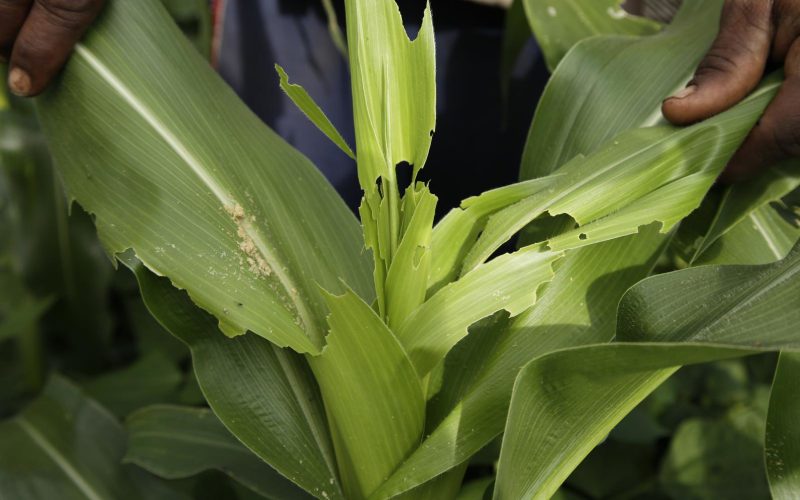
Farmers are reporting the attack of fall armyworms on their farms. This destructive pest gets its name because it travels in small insect armies and consumes just about everything in its way. Drought conditions are favourable for the fall armyworm. Fall armyworms can be found at the beginning of cool whether. However, the risk of damage declines as it gets cooler because the pest develops more slowly in low temperatures.
Fall armyworm caterpillars damage plants by chewing plant tissue. The pests are typically most active early in the morning, late in the afternoon, or early evening, but they can be observed feeding on plant foliage during daytime. The damage often seems to appear overnight. Young armyworms don’t eat much. Almost all the damage is caused by the oldest caterpillars, which consume more than the other ages. Therefore, an infestation may have been present but not detected because of the small size of the caterpillars.
Damage
Larvae feed on corn leaves and may attack corn’s tassels and ears. Their damage appears as ragged-edged holes on leaves, tassels and ears. Severe feeding may give the appearance of corn that has been damaged by hail. The damage may vary in appearance and severity in grass and hayfields. The grass may seem to thin out and develop brown in grazing fields. These spots look burned or browned out. This appearance results from grass plants rapidly dehydrating after fall armyworm larvae have chewed off the tender foliage. For this reason, fall armyworm damage often resembles drought damage.
Identification
Fall armyworm moths are primarily grey with white markings and usually have a drop-shaped mark in the middle of the forewing. Adults may be up to one inch long with a wingspan reaching one and a half inches. Larval stages range in colour from green and yellow to brown and grey and can reach one and a half inches in length. The distinguishing characteristic of larvae is the presence of a yellow to white upside-down ‘Y’ shape on the head. Egg masses are white to cream and usually have a furry or mouldy appearance, with eggs darkening in colour over time.
Scouting for fall armyworms is necessary only in fields where larvae or their damage are noted. Sampling should be conducted in five areas of a field. In each of the five areas, randomly select a plant as the first of a sample set of 20 consecutive plants. Carefully examine each plant to determine the number of damaged plants in each sample set. From these numbers, determine the percentage of plants damaged in the field. Also, note the number of larvae observed and estimate their size (length). Finally, calculate the portion of the field infested and note the location of the infestation.
Control
Use pheromone traps to monitor the arrival of moths. When you first notice them, look for the distinctive white dot on their forewings; it’s time to start a closer inspection of your plants. Look for larvae and signs of the damage beginning in early spring. Caterpillars will often be found feeding on the undersides of leaves and new growth. Handpick the worms you discover, and don’t be tempted to crush them between your thumbs. Instead, drop them in a bucket of soapy water.
The application of an insecticide is usually not economical for control of the fall armyworm.
However, it may be necessary if the infestation is extremely severe and the plants are under stress. If 75 per cent of the plants’ exhibit whorl feeding damage and larvae are less than one to a quarter inches long, and the plants are under stress, treatment may be advisable. If high levels of damage are noted in isolated areas of a field, spot treatments may be warranted.
Use insecticides containing active ingredients, such as bifenthrin, Bacillus thuringiensis (B.t), cyfluthrin, cypermethrin, lambda-cyhalothrin, permethrin, or spinosad. When using contact insecticides, remember to avoid any irrigation or rainfall within 24 hours of application to allow for the maximum amount of time for impact on the armyworms.
 The Standard Group Plc is a
multi-media organization with investments in media platforms spanning newspaper
print operations, television, radio broadcasting, digital and online services. The
Standard Group is recognized as a leading multi-media house in Kenya with a key
influence in matters of national and international interest.
The Standard Group Plc is a
multi-media organization with investments in media platforms spanning newspaper
print operations, television, radio broadcasting, digital and online services. The
Standard Group is recognized as a leading multi-media house in Kenya with a key
influence in matters of national and international interest.
 The Standard Group Plc is a
multi-media organization with investments in media platforms spanning newspaper
print operations, television, radio broadcasting, digital and online services. The
Standard Group is recognized as a leading multi-media house in Kenya with a key
influence in matters of national and international interest.
The Standard Group Plc is a
multi-media organization with investments in media platforms spanning newspaper
print operations, television, radio broadcasting, digital and online services. The
Standard Group is recognized as a leading multi-media house in Kenya with a key
influence in matters of national and international interest.





